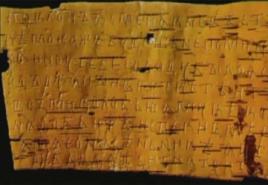Academician Osipian. Yury Andreevich Osipian
Yury Andreevich Osipian
1931-2008
Academician Yuri Andreevich Osipian- An outstanding scientist and organizer of domestic science, which introduced an invaluable contribution to the development of the physics of the condensed state of the substance, the physics of the strength and plasticity of solids. Academician Osipjan is the founder of the Institute of Physics solid RAS, for many years he was a member of the Presidium of the Russian Academy of Sciences and the USSR Academy of Sciences, Chairman and a member of the Presidium of the Scientific Center of the Russian Academy of Sciences in Chernogolovka, advisor to the President of the USSR.
Yury Andreevich Osipian was born on February 15, 1931 in Moscow. In 1955, he graduated from the Moscow Institute of Steel and Alloys in the specialty "Metallurg Engineer" and began scientific work at the Institute of Metal Science and Metal Physics of the Central Research Institute of Black Metallurgy. In parallel, he received an additional theoretical education on Mehmate MSU. M.V. Lomonosov. In 1962, under the leadership of Academician G.V. Kurdyumov, he defended his dissertation. Outstanding talents of Yuri Andreevich, a scientist and the organizer, manifested themselves with the organization, formation and development of the Institute of Solid State Physics. From 1962 to 1963, Yu.A. Visipias was the Deputy Director for scientific work Institute of Crystallography of the USSR Academy of Sciences of the USSR, from 1963 to 1973 - Deputy Director for Research and from 1973 to 2002 - Director of the Institute of Physics of the Solid State Academy of Sciences of the USSR. In 2002, Academician Yu.A. Pisel became the supervisor of the Institute of Physics of the Solid State RAS.
Yury Andreyevich gave her talent of an outstanding scientist Yury Andreyevich. They published more than 200 scientific papers on the theory of phase transformations, physics of strength, physics of electrical and magnetic phenomena, physics of semiconductors, optics, etc. In the early 1960s, Yu. A. Osipian began to conduct pioneer experimental studies related to the study of the interaction of electrons with extended defects in crystals. During this period, he opened an unexpected and interesting phenomenon, which is currently known in scientific literature as photoflastic effect. Yu. A. Osipjan, together with students, discovered the electoplastic effect and the presence of charge on dislocations in semiconductors A2B6, the existence of clusters of "torn" valence bonds in dislocation nuclei in silicon, electronic spin resonance and spin-dependent recombination on dislocations. Elegant high-frequency conductivity experiments led to the detection of quasi-one-dimensional electronic zones associated with dislocations and combined electron resonance on dislocations in silicon. The effect of the magnetic field on the plastic deformation of superconductors was established and it was shown that the state of the electron system strongly affects plastic deformation, i.e. On the movement of dislocations through the crystal under study, and, in turn, the administration of dislocations leads to a change in the properties of the electronic system in plastically deformed crystals. Of the first experiments on electronic paramagnetic resonance on the torn relations, a powerful method for diagnosing semiconductors - EPR spectroscopy of defects in semiconductors has developed.
All these works served as the establishment of a new, successfully developing area of \u200b\u200bphysics - dislocation physics in semiconductor crystals. The contribution of Yu. A. Osipian and created by him scientific school In the development of this direction, a solid physics was widely international recognition, and russian science In the area of \u200b\u200bthe dislocation physics of the solid, the leading position ranked. In 1972, Yuri Andreevich was elected a corresponding member of the USSR Academy of Sciences and in 1981 by Academician of the USSR Academy of Sciences. For research in the field of dislocation physics in 1984, Yu. A. Osipian was awarded the USSR Academy of Summary by one of the highest awards in physics - the gold medal. P. N. Lebedeva. Later he was awarded an international award and a gold medal. A. P. Karpinsky.
Brilliant talent of the supervisor Yu.A. Osipian has demonstrated by creating and leading the state program of the USSR on high-temperature superconductivity. According to his proposal, a number of studies of structural and physical properties The crystals of high-temperature superconductors, in particular, studied the structure of the magnetic flux in the superconductor, conductivity anisotropy. The research conducted under his leadership quickly won credibility and international recognition in this actual field of physics. Invaluable the contribution of Yuri Andreevich to the organization scientific research On the scale of our country, which he carried out, being at various high posts in the structure of the Presidium of the Russian Academy of Sciences.
The organization and formation of the Institute of Physics of the Solid State RAS, the selection and education of scientific personnel, ensuring and maintaining a high scientific research in it in him. Currently, IFTT RAS is one of the largest academic institutions of the physical profile in Russia, is a recognized scientific center, where a wide range of studies in the field of condensed state physics and physical science is carried out.
Yury Andreevich Osipian was an excellent teacher and educator of scientific personnel. On his initiative, the Department of Physics Physics of the Moscow Institute of Physics and Technology and the Branch of the Department of Physical Chemistry of the Moscow Institute of Steel and Alloys of the Moscow Institute of Steel and Alloys were created at its initiative in Chernogolovka. Over the years, he has lectured to students and graduate students. To the very last days His life was headed by the department of physics of the solid body of the MFTI. Under the leadership of Yu.A. Vispician defended the dissertations of dozens of future large Russian scientists. Later, at the initiative of Yuri Andreevich, the Physico-Chemical Faculty of Moscow State University was created, which is now working successfully, gaining strength and authority.
The merits of Yury Andreevich received extensive international recognition. He was a foreign member of the National Academies of Bulgaria, Hungary, Poland, the Czech Republic, a member of the National engineering Academy USA, International Academy Astronautics, he successfully headed the International Union in the field of clean and applied physics (IUPAP). The merits of Yu.A. Sykia are reflected in the highest government awards. In 1986 he received honorary title Hero of Socialist Labor, in 1999 was awarded the Order "For merits to the Fatherland of II degree." In 2005, Yu.A. Piscean was awarded the highest award Russian Academy Sciences Great Gold Medal of the Russian Academy of Sciences. M.V. Lomonosov 2005 for the fundamental contribution to the physics of dislocations in solids and the opening of the photoplastic effect.
Yury Andreevich Osipian (1931-2008) - Soviet, Russian physicist, academician of the Russian Academy of Sciences, Advisor RAS, Doctor of Physical and Mathematical Sciences. Foreign member of the Bulgarian An (1989).
Biography
- Vice President of the USSR Academy of Sciences (1988-1991), Vice-President of the Russian Academy of Sciences (1991-2001), Chairman of the Board of Directors of the Noginsk Scientific Center of the Russian Academy of Sciences.
- Member of the Presidential Council of the USSR (1990)
- Director (since 2002 scientific director) Institute of Physics of the Rough Body
- Head of the Department of Physics of the Faculty of Physics of the Faculty of General and Applied Physics of MFTI (1964-)
- Head of the Department of Physics Condensed State of the Physical Faculty of Moscow State University. M. V. Lomonosov
- People's Deputy of the USSR (1989-1991)
- Dean of the Physico-Chemical Faculty of Moscow State University. M. V. Lomonosova (2006-2008)
- He was the first vice-president of the International Union of Theoretical and Applied Physics.
- He was the editor-in-chief of the magazine "Surface: Physics, Chemistry, Mechanics", a member of the editorial board of the magazine "Crystallography", Chairman of the Editorial College of Librar "Kvant" (Publishing House "Science")
Author (together with Irina Borisovna Savchenko) scientific opening "Photographic effect", which is listed in the state register of the USSR discoveries under No. 93 with a priority of December 21, 1967 in the following wording: "A previously unknown phenomenon was established in changing the resistance of plastic deformation of semiconductor crystals under the action of light, and the maximum change occurs when The wavelengths corresponding to the edge of their own absorption of crystals. "
Yury Andreevich Osipian died on September 10, 2008 in Moscow. He was buried in the Makarov cemetery.
Awards
- Hero of Socialist Labor (1986)
- Order "For Merit to Fatherland" II Degree (1999)
- Order of Lenin (1981, 1986)
- Order of the Red Banner of the Red Banner (1971, 1975)
- Big gold medal named after M. V. Lomonosov, 2005 - for the fundamental contribution to the physics of dislocations in solid bodies and the opening of the photographic effect
- Gold medal wounds. P. N. Lebedeva, 1984 - for the cycle of works "Investigation of the influence of light on plastic deformation of crystals and the opening of the photographic effect"
- Order Simon Bolivar (Colombia), 1990
- Order of the Honorary Legion (France), 1990
- Karpinsky Prize (Germany), 1991
The well-known Russian scientist, physicist Yuri Osipyan died on Wednesday night in Moscow on the 78th year of life, RIA Novosti reported in the press service of the Russian Academy of Sciences.
Yury Andreevich Osipian was born on February 15, 1931 in Moscow. In 1955, he graduated from the Physics and Chemical Faculty of the Moscow Institute of Steel and Alloys and in the same year entered Moscow state University them. M.V. Lomonosov at the Mechanics and Mathematics Faculty, which graduated in 1960. In parallel, Yuri Osipyan was engaged in scientific work: in 1955-1960 he worked as the younger, then the Senior Researcher of the All-Union Research Institute of Black Metallurgy.
In 1962 - 1963, he held the position of deputy director for the scientific work of the Institute of Crystallography of the USSR Academy of Sciences.
In the early 1960s, Yuri Osipyan was engaged in the study of the interaction of electrons with extended defects in crystals and made the discovery that was called the "Photoflastic effect". His works contributed to the formation and successful development of a new direction - dislocation physics in semiconductor crystals.
Osipjan was one of the founders of the Institute of Solid State Physics (IFTT) in the village of Chernogolovka of the Moscow Region. Since 1963, he worked at the IFTT RAS as Deputy Director, since 1973 - Director of the Institute.
In 1968, Yuri Osipyan defended his doctoral dissertation; In 1972 he became a member of the RAS correspondent; In 1981 - academician. He was a professor at the Moscow Institute of Physics and Technology.
In the mid-1980s, on his initiative, and under his leadership in IFTT, a state program was developed and implemented on the problems of high-temperature superconductivity. He first introduced a competitive system of scientific projects in the country, which changed the management of science as a whole.
In 1990 - 1994, he was the president of the International Union of Clean and Applied Physics (IUR), in 1988-1991, the Vice-President of the USSR Academy of Sciences, from 1991 to 2001 - Vice President of the Russian Academy of Sciences, since 2001 he had an adviser to the Presidium of the Russian Academy of Sciences.
For many years, he was chairman of the Presidium of the Scientific Center of the Russian Academy of Sciences in the city of Chernogolovka (until 1998 - the Noginsky Scientific Center of the Russian Academy of Sciences). He was a member of the National Academies of Sciences Bulgaria, Hungary, Poland, the Czech Republic, USA. Member of the International Academy of Astronautics.
Osipian headed a number of public and scientific organizations. He was the chairman of the Scientific Council on the Physics of the Solid State RAS, the Committee of Russian scientists for disarmament, the National Committee of Russian Crystallographs. In addition, he was elected a member of the CSCPAR International Committee and a member of the Council of the European Physical Society.
Since 1988, Yuri Osipian has been the President of the Society "Russia - Germany", as well as a member of the Russian (until 1992 - Soviet) of the Paguch Committee; In 2001, he was approved by a member of the Presidium of the Committee.
In the number of his awards, two orders of the Red Banner of the Red Banner (1971 and 1975), two orders of Lenin (1981 and 1986), the Order "For merit to the Fatherland" II degree (1999). In 1984, Yuri Ospyan was awarded one of the highest awards in physics - the Golden Medal of the Russian Academy of Sciences. PN Lebedeva.
The merits of the scientist are also noted at the international level: in 1988 - a prize and a gold medal. A.P. Karpinsky (Germany), in 1990 - the Order of Simon Bolivar (Colombia).
In 2006, Academician Yury Ospyan was awarded higher award Russian Academy of Sciences - Big Gold Medal. M.V. Lomonosov.
Material prepared on the basis of RIA news and open sources







